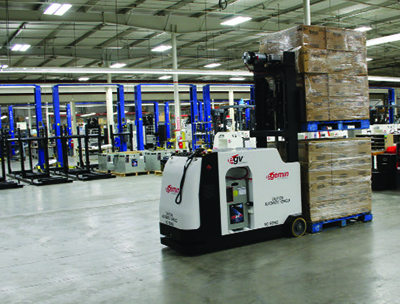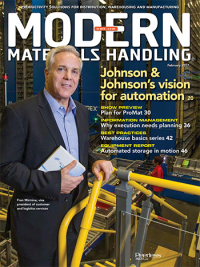Automated Storage on the Move
To meet increasingly extreme demands, automated storage systems in distribution and manufacturing applications are working to take the static out of storage and keep product and enterprise on the move.
In a world built on speed, storage might be defined as the exact opposite. A product sitting on a shelf is not an asset waiting for its moment, but an expense, a pause in the flow of goods, a liability. The goal, then, is to shorten the amount of time anything spends sitting in one place, whether product, workers or equipment. Automated storage systems have spent recent decades enabling efficiency, accessibility and predictability, but many of their strengths can turn into liabilities. As solution providers and users continue to adapt, the role of automated storage is also in flux.
“The very definition of storage is changing, since nothing sits around very long with the pressure to keep things on the move,” says Rick Graff, senior product manager of integrated systems for Intelligrated. “There’s a big push for a more modular idea about how you use automation. Maybe you start small and expand, or deploy in targeted areas. You don’t have to go all-in on day one.”
Layered or mixed-case pallets are replacing full-pallet orders for store replenishment—even for larger retailers. The proliferation of stock-keeping units (SKUs), dramatic seasonal peaks and the rise of e-commerce make the future much less certain. 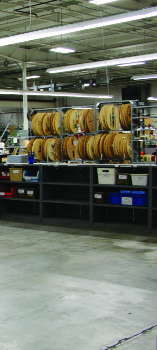
“It’s important to understand that customers can expect their automated storage system will need to change,” says Ken Ruehrdanz, manager of the distribution systems market for Dematic North America. “The idea of set it and forget it is gone. We’re finding that for many users, it’s not six months after we turn over the system before changes are needed. Say a customer wants to optimize around 10% single-line orders, 80% multi-line. When a year later they’re at 40% to 50% single-line, that will change the dynamic of the system.”
The industry is prioritizing modularity, scalability and flexibility. In the process, the umbrella of “automated storage” is expanding to include tools like automatic guided vehicles and workstation design, as well as new software and processes that transform the functionality of familiar automated storage technologies.
Buffed-up efficiency
Ruehrdanz says that there are five most common applications for automated storage and retrieval systems (AS/RS). In order of popularity:
- Goods-to-person and kitting, with AS/RS as the engine that supports the operation.
- Pick face replenishment, whether a unit load, mini-load, or shuttle automatically replenishes active pick faces.
- Mixed-case palletizing support. Customers need a storage machine to sequence and feed cases. Mini-loads are ideal here.
- Order consolidation buffer. In distribution, say an order has been picked and is ready to ship but needs to wait for the carrier. Whether the wait is 30 minutes or 12 hours, the order can be delivered and sequenced precisely for truck loading.
- AS/RS to support production as buffer storage for raw materials and finished goods.
Because it must account for more complex orders, returns and sequencing of all kinds, automated storage does not simply serve as a waypoint on a straight line of material movement. Instead of fast and efficient movement from A to B, these systems are expected to bounce around the entire alphabet. There will always be a place for conventional, monolithic unit-load AS/RS for reserve storage, but they are increasingly surrounded by dynamic automation.
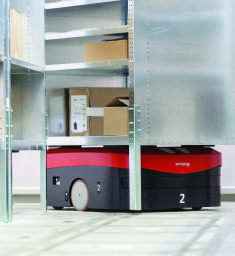
“I think the market is changing faster than it ever has,” says Bruce Bleikamp, sales manager for Cimcorp. “We see a lot of interest in buffer storage systems that also act as order fulfillment systems, supporting piece picking or layer picking, and building mixed-SKU pallets. Customers also want the ability to take apart those pallets and pick individual cases or layers and marry them together. This kind of solution doesn’t take over the role of a traditional unit load AS/RS, but augments it while granting even higher control of inventory.”
Buffer solutions are proving valuable in distribution as well as manufacturing. Terry Krantz, vice president of sales and consulting of automotive for Swisslog, describes a manufacturing process involving automated delivery to four cells. In the past, production supply was always sequential, moving from one cell to the next. If one cell moved at 1,000 parts per minute (ppm) and the next at 1,200; the result is a wasted 200 ppm in the second cell. Using automatic guided vehicles (AGVs) capable of delivering to cells based on need and buffering to balance workloads, the process can store some work-in-progress and optimize the overall equipment efficiency.
“This offers flexibility, but it also becomes a lever you can pull to control manufacturing efficiency,” Krantz says. “Storage now becomes integral and critical to the manufacturing process, where in the past it was an afterthought. It can enable you to hold less inventory while making the best possible use of what you have, when and where.”
Whether AGVs or carousels supply dynamic buffer storage during production, the same systems can manage the movement of finished goods.
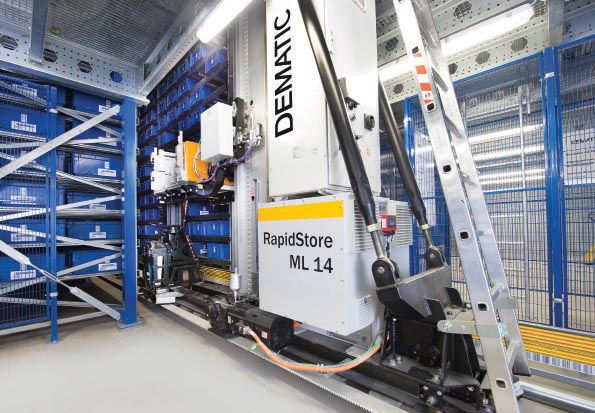
“Tier 1 manufacturers are really fantastic at highly automated manufacturing processes, but many times goods come out of automated cells and might as well be strapped to donkeys and carried to the corner of the warehouse,” Krantz says. “There is little to no technology there. As industries like automotive pivot, they are realizing they have enormous need to manage that material movement.”
Automation was always about making processes more efficient and faster, Krantz says, but people assumed that flexibility was limited. “For most of my career, flexibility was degraded as you went to higher levels of automation,” he says. “Now many solutions can offer high degrees of flexibility, and often even higher than manual processes. You can scale at the drop of a hat with minimal disruption, which generally didn’t go hand in hand with automation.”
Tom Kaminski, CEO of Egemin Automation, says the AGV form factor enables scalability. In very narrow aisle applications, unlike a captive crane or shuttle, an AGV can come into and out of an aisle and perform other movements to induct, stage or deliver.
“We have customers anticipating growth, but the idea of building a new facility is too slow,” Kaminski says, “They can’t wait nine months for a new automation system, even if they can justify it. They might put equipment in their existing warehouse to increase density as a stop-gap short of their grand vision. Then, they can repurpose that equipment within the same facility. It’s an incremental way to get into automation.”
The smartest move
Automated storage equipment can be judged on how versatile, mobile, speedy and predictable it is, but whether it’s a state-of-the-art AGV or a 20-year-old crane, the software is the real star. Software allows precise sequencing of loads, using algorithms to optimize movement within a storage system. It will help position fast-movers near the closest location, support duplicate locations, or help with inventory grooming.

“Basic software is: Find a spot, stick it there,” Ruehrdanz says. “We’re now moving toward more and more optimization. For example, the system might sequence so the right load gets to the right workstation at the right time to build a pallet or get pieces to the right container for an order. This type of functionality can be added to an existing system to get more throughput from the same mechanical system.”
Ruehrdanz explains that new storage location management algorithms support random and strategic staging of inventory for optimized system performance. The software supports precise sequencing for goods-to-person workstations and mixed case palletizing as well as the ability to transfer loads between storage aisles within the rack structure. Typical location management considerations include SKU velocity, weight, cube and family groups. Software also enables retrieval strategies like first in, first out (FIFO); last in, first out (LIFO); or first expired, first out (FEFO).
Software will also help inform equipment configurations. Mark Dickinson, executive sales manager of the automated systems division for SSI Schaefer Systems International, offers the example of a mini-load AS/RS with five aisles and one shuttle per aisle. For a 500-case pallet, it’s a straightforward process for five mini-loads to go down aisles and put together the order in an hour, following the general average of 100 dual cycles per aisle per mini-load. However, if the order must be prepared in aisle-ready sequence, with all juices on one layer and cheeses on another, for example, then the shuttles will be trying to access the same SKUs at the same time. This can create congestion and might point toward additional aisles, additional shuttles and duplicate locations.
“Every constraint puts more demand on the equipment,” says Dickinson, who adds that many automated storage technologies have become somewhat similar. “It’s not quite a commodity, but the differentiating factor becomes software.”
Software will manage order flow and workloads, but also benefits from broader information about sales patterns. Intelligrated’s Graff says the more information fed to automated systems, the smarter they can be. Without data about product velocity, the system won’t know to move a fast-moving product closer to the outbound side. If near-term demand is unknown, it isn’t possible to prepare for spikes.
“Everyone’s trying to figure out the next step, how to improve on what we have in regard to location management,” Graff says. “A lot of customers are seasonal, and want to rank inventory and SKUs by how fast they move. But as seasons change, inventory optimization changes. It might make sense to move a SKU out of automation into a manual pick zone, or vice versa. One customer might expect a 100,000-location system that continually keeps SKUs on the rack. We might determine they only need 40% of that in automation, and can show them how to evolve the inventory.”
Companies mentioned in this article:

Article Topics
Equipment Report News & Resources
Radial stays ahead of the automation curve Wireless Mobility: Ready for the next leg up AGVs set new standards for inventory transportation Inside North Shore Care Supply: Bringing robots to receiving Bergen Logistics: Putting robots to work in a multi-tenant facility High-tech meets low-tech: Automate storage for pallet loads Tuggers, carts work together to increase productivity and ergonomics More Equipment ReportLatest in Materials Handling
Registration open for Pack Expo International 2024 Walmart chooses Swisslog AS/RS and software for third milk processing facility NetLogistik partners with Vuzix subsidiary Moviynt to offer mobility solutions for warehouses Materials Handling Robotics: The new world of heterogeneous robotic integration BSLBATT is looking for new distributors and resellers worldwide Lucas Watson appointed CSO for Körber’s Parcel Logistics business in North America Hyster recognizes Dealers of Distinction for 2023 More Materials HandlingAbout the Author
Subscribe to Materials Handling Magazine

Find out what the world's most innovative companies are doing to improve productivity in their plants and distribution centers.
Start your FREE subscription today.
April 2024 Modern Materials Handling

Latest Resources


